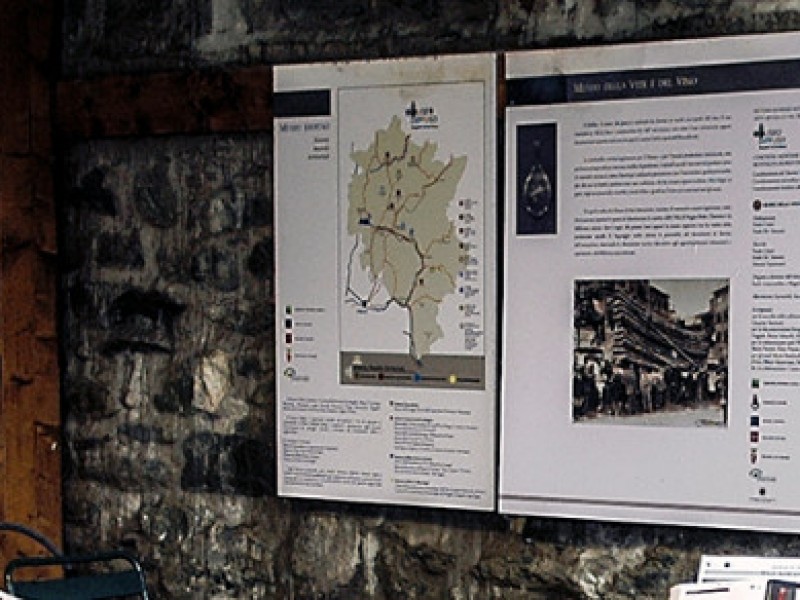 The "Clock Tower" in Piazza Cavour
The "Clock Tower" in Piazza Cavour
Borgo San Lorenzo town centre is the most interesting start for your tour. Two gates welcome you to the town: Fiorentina and Orologio, part of the ancient walls built in 1351. A visit to San Lorenzo Parish Church, built in 941 houses excellent works of art, such as: the Madonna attributed to Giotto, a panel of the Crucifix of the Giotto school, the Madonna on the Throne with Child attributed to Agnolo Gaddi, and the Virgin and the Saints Francis and Dominic by Matteo Rosselli. The apse was frescoed by Galileo Chini. To the right of the church we find a lovely polychrome terracotta tabernacle produced by the Fornaci Chini.
From 2017, Borgo San Lorenzo is appointed "Città della Ceramica", official approval from Ministero delloSviluppo Economico.
Not far from the city centre, we find the Oratorio del Santissimo Crocifisso dei Miracoli, built to hold a painted wooden Crucifix left there in 1400 by German pilgrims fleeing the plague.
Villa Pecori Giraldi houses the Chini Museum, a permanent collection of masterpieces by the artist Galileo Chini and his family, the Chini Contemporary, which hosts temporary exhibits of contemporary art, and the Kids Museum, an interactive area for families
On the hills that surround Borgo San Lorenzo is the Museo della Civiltà Contadina di Casa d’Erci, a farm house was restored and furnished using period pieces from the 19th and 20th centuries. Before reaching the Museum is the Mulino ad acqua Faini (Faini water mill), built in the 15th century.
The Mulino ad acqua Margheri (Margheri water mill) located in Madonna dei Tre Fiumi, built in roughly 845, is still in perfect working condition. Visitors are welcome to view the grinding process and to buy wholesome wheat flour, corn flour or chestnut flour. On the opposite side of the road stands an Oratory, built roughly in 1578. The Colla di Casaglia Pass is not far off, and from it run a number of trails through the Giogo Casaglia Forestry complex or down through chestnut groves to the town of Ronta. The trails are suited for both trekking and MTB.
Art and faith
The S. Lorenzo Parish Church, built in 941, is the biggest Romanesque construction in Mugello with the bell tower, set on the semicircular apse and built in brick in the shape of a semi dodecagon. The magnificence of the works of art held within the church is testimony of its past importance. Among these a Madonna, attributed to Giotto and masterpieces by the Chini Family. Tel. +39 055 8459295
The SS.Crocifisso dei Miracoli Orator, was built in the 18th century to hold a wooden Crucifix, left here in the 15th century by some German pilgrims who were fleeing from the plague. Tel.+39 055 8459088
The San Francesco Church holds an extensive nave in Gothic style, the remains of 14th century frescos, and a chapel, all made from bits of pebbles from the river.
In the countryside, we find:
- The Cappuccini di San Carlo Convent, which dates back to 1613, with masterpieces by the Chini and a 33 metre well which was drilled in 1617. Tel. +39 055 8459385
- The San Giovanni Maggiore Parish Church, a 10th century structure with an octagonal 11th century bell tower, a striking 12th century marble ambo and glass panes by Chini Manufacturing. Tel.+39 055 8403378
- The Madonna dei Tre Fiumi Sanctuary was built in 1578. According to the legend, some women were praying in front of the tabernacle, where today we find the Sanctuary, when the face of the Blessed Virgin materialized and began to cry. Many pilgrims visited the site to beg for “grace” and numerous miracles are said to have taken place there. Tel . +39 055 8403015 c/o Tre Fiumi Hotel or tel.+39 055 8403014
- The Vallombrosian Abbey of San Paolo, founded in 1035 by St. Giovanni Gualberto in Razzuolo.
- The 11th century Romanesque Parish Church in Faltona with the 12th century bell-tower.





























